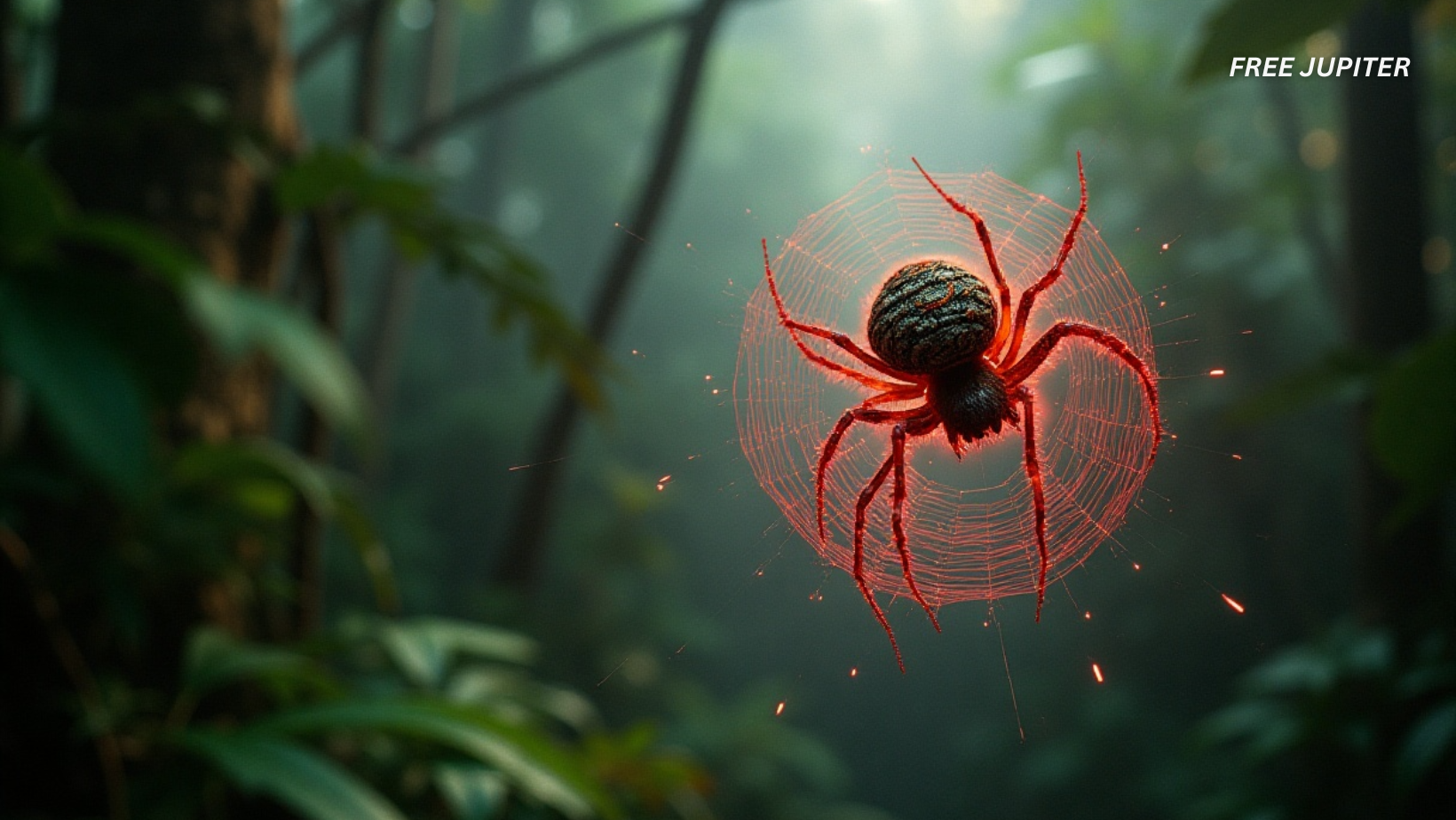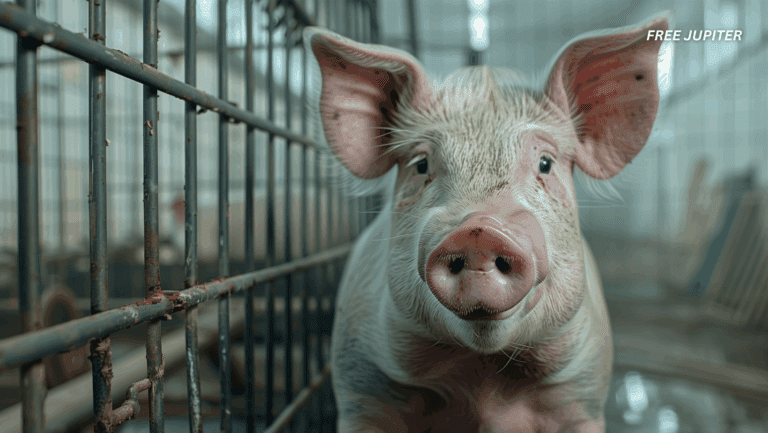Friendly Note: FreeJupiter.com shares general info for curious minds 🌟 Please fact-check all claims—and always check health matters with a professional 💙
In an unassuming lab in Bayreuth, Germany, a scientific marvel quietly unfolded — one that feels like a plot twist straight out of a superhero origin story. For the first time ever, a team of genetic researchers has successfully engineered a spider to produce silk that glows a vivid red under ultraviolet light. This striking development isn’t a Hollywood special effect, and it’s rewriting the rules of bioengineering.
The remarkable feat was achieved through the use of CRISPR-Cas9, the Nobel Prize-winning gene-editing tool that has revolutionized the field of genetics. The scientists, led by biochemist Thomas Scheibel at the University of Bayreuth, managed to modify the genetic code of Parasteatoda tepidariorum, a common house spider, embedding a gene that enables the creature to spin fluorescent silk.
But this isn’t just about creating glowing threads for dramatic flair. This achievement marks the first time CRISPR has been effectively used in spiders — an animal group notoriously tricky to manipulate genetically — and opens the door to a future of highly customizable biomaterials.
Overcoming Evolutionary Obstacles
Spiders, while biologically fascinating, present serious challenges to genetic engineering. Unlike more commonly studied lab animals like mice or fruit flies, spiders have a finicky biology that doesn’t lend itself easily to gene tinkering. For decades, researchers have struggled to find a reliable method for modifying arachnid DNA.
Scheibel and his team took a bold approach by targeting the spiders’ oocytes — the unfertilized eggs inside anesthetized female spiders. Using precision microinjection techniques, they introduced CRISPR components directly into these egg cells. This process allowed them to alter the DNA before it merged with male genes during fertilization, sidestepping the complex zygotic processes that often complicate genetic editing in arthropods.
As a test run, the team first edited a gene responsible for eye development called sine oculis. The resulting offspring hatched without eyes — a startling but clear indicator that the gene-editing technique had worked. This step laid the groundwork for more sophisticated modifications.
Shifting the Focus to Spider Silk
Having confirmed that they could perform genetic knockouts in spiders, the researchers turned their attention to something with wider scientific appeal — silk. Spider silk has long enchanted scientists due to its extraordinary mechanical properties. It is stronger than steel by weight, yet more elastic than most synthetic materials, and it’s biodegradable to boot.
The team zeroed in on the genes responsible for creating spidroins, the structural proteins that form spider silk. Into this genomic region, they inserted a DNA sequence that codes for a red fluorescent protein. The idea wasn’t just to make glowing silk — it was to prove that CRISPR could successfully reprogram spiders to produce silk with new characteristics.
When the edited spiderlings matured, some began spinning threads that lit up red under UV light — a clear sign that the modified protein had become part of the silk’s composition. For Scheibel and his team, this was the eureka moment: they had successfully demonstrated that it’s possible to genetically enhance spider silk at its molecular foundation.
Read more: A New Shape-Shifting ‘Flapjack’ Octopus Has Been Discovered in the Deep Sea Near Australia
A Glimpse into the Future of Biofibers
What makes this achievement more than just a dazzling laboratory trick is the potential it unlocks. Spider silk, thanks to its combination of strength, flexibility, and environmental friendliness, has been a long-sought target for industrial and medical use. However, traditional spider silk farming is unfeasible — spiders are territorial and cannibalistic, making them terrible livestock.
Attempts to synthesize spider silk using bacteria, yeast, or even goats have seen partial success, but these methods often fall short of replicating the real thing. Being able to engineer spiders themselves to produce specialized silk could be a game-changer.
Tailoring the properties of silk at the genetic level may pave the way for fibers optimized for specific uses — such as biodegradable sutures, flexible implants, lightweight armor, or even aerospace components. Imagine a world where surgical threads can glow for visibility under specific lighting, or fabrics can be custom-designed to change color or respond to environmental stimuli.
Read more: What The Largest Shark To Ever Exist Really Ate To Meet Its 100,000-Calorie Daily Requirement
Not Just a Party Trick
While glowing red silk may sound like a gimmick, it serves a critical function in the experiment: visibility. The fluorescent quality acts as a marker, confirming that the inserted gene is indeed being expressed in the spider’s silk production process. This makes it easier for researchers to trace the effects of their modifications and fine-tune the procedure for future applications.
But even beyond the glow, this breakthrough is about control. For the first time, scientists have shown that spider silk can be functionally altered by reprogramming its biology — not just mimicking it through synthetic means. It’s a demonstration of possibility, not a finished product.
Scheibel and his team emphasize that the current study is a proof of concept. There’s still a long road ahead before genetically modified spider silk becomes a staple in manufacturing or medicine. But the success of this initial endeavor is enough to spark serious interest in the scientific community.
Ethical Considerations and the Road Ahead
Any time genetic engineering is involved, ethical questions inevitably follow. Could genetically altered spiders become invasive or cause unforeseen ecological consequences if released into the wild? In this case, the modifications are confined to a controlled lab setting, and there is no current plan to release these spiders outside strict research environments.
However, the implications do raise broader questions about the direction of bioengineering. If spiders can be programmed to produce customized materials, what other organisms might be tapped for similar feats? Could we see the rise of biofactories where living creatures are genetically optimized to create materials we’d otherwise manufacture synthetically?
Scheibel believes the future will be about synergy — blending biology with engineering in ways that enhance both fields without overstepping ethical boundaries. With careful oversight and transparent research practices, genetically programmed biomaterials could offer a sustainable path forward in industries ranging from textiles to electronics.
Read more: Bedbugs Are The Very First Human Pest, And They Have Been Bugging Us For 60,000 Years
A Silk Thread Connecting Science and Wonder
This glowing silk spun by genetically edited spiders is more than a quirky novelty. It’s a tangible glimpse into the next chapter of biomaterials research. What once seemed the domain of comic books and science fiction — organisms producing enhanced, even fantastical, substances — is now becoming an experimental reality.
By pioneering CRISPR gene editing in spiders and successfully embedding a fluorescent trait into their silk, the team at the University of Bayreuth has set the stage for innovations that could change how we think about materials science. And while these threads may currently be spinning inside a lab in Germany, their impact could stretch across the globe in time.
From eye gene experiments to silk with a crimson glow, the work doesn’t just push scientific boundaries — it reinvents them. This spider silk story may not involve skyscrapers or superheroes, but it has all the makings of something just as thrilling.










